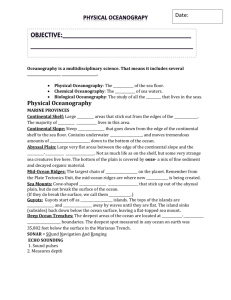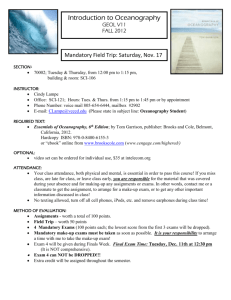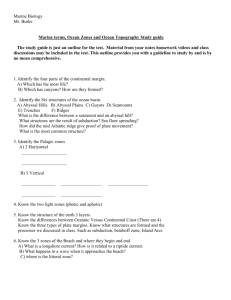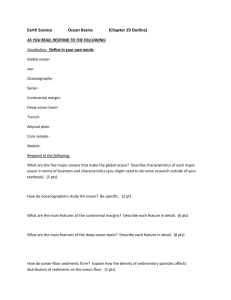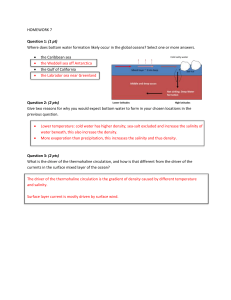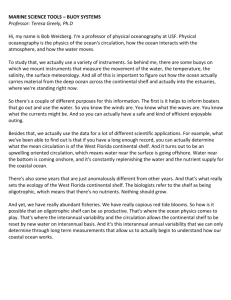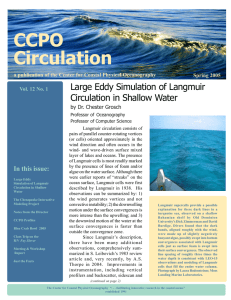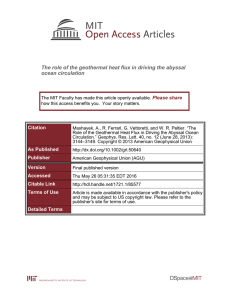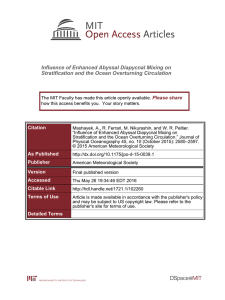practice exam
advertisement
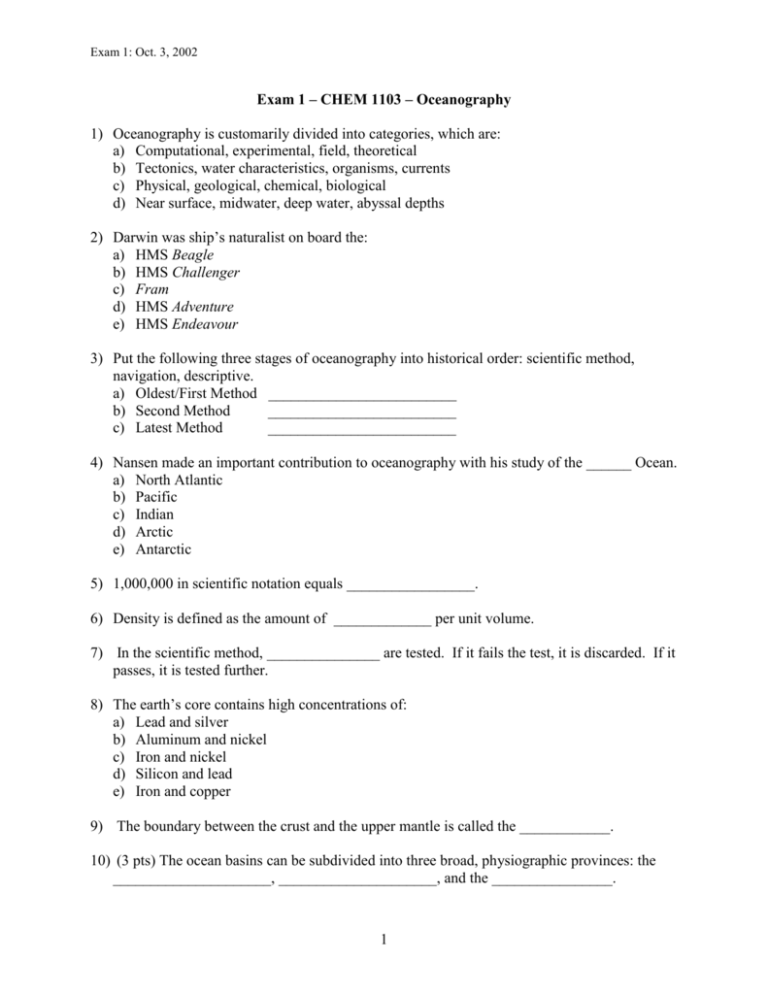
Exam 1: Oct. 3, 2002 Exam 1 – CHEM 1103 – Oceanography 1) Oceanography is customarily divided into categories, which are: a) Computational, experimental, field, theoretical b) Tectonics, water characteristics, organisms, currents c) Physical, geological, chemical, biological d) Near surface, midwater, deep water, abyssal depths 2) Darwin was ship’s naturalist on board the: a) HMS Beagle b) HMS Challenger c) Fram d) HMS Adventure e) HMS Endeavour 3) Put the following three stages of oceanography into historical order: scientific method, navigation, descriptive. a) Oldest/First Method _________________________ b) Second Method _________________________ c) Latest Method _________________________ 4) Nansen made an important contribution to oceanography with his study of the ______ Ocean. a) North Atlantic b) Pacific c) Indian d) Arctic e) Antarctic 5) 1,000,000 in scientific notation equals _________________. 6) Density is defined as the amount of _____________ per unit volume. 7) In the scientific method, _______________ are tested. If it fails the test, it is discarded. If it passes, it is tested further. 8) The earth’s core contains high concentrations of: a) Lead and silver b) Aluminum and nickel c) Iron and nickel d) Silicon and lead e) Iron and copper 9) The boundary between the crust and the upper mantle is called the ____________. 10) (3 pts) The ocean basins can be subdivided into three broad, physiographic provinces: the _____________________, _____________________, and the ________________. 1 Exam 1: Oct. 3, 2002 11) When the Earth was a molten mass, its elements and compounds separated from each other according to their _________________. a) Atomic number b) Density c) Magnetism d) Radioactivity e) Specific Heat 12) The asthenosphere is a portion of the: a) Crust b) Mantle c) Outer core d) Inner core 13) Which of the following is not characteristic of the deep sea basins? a) Canyons b) Plains c) Hills d) Seamounts e) Guyots 14) Which of the following are associated with active volcanoes and strong earthquakes? a) Abyssal plains b) Abyssal hills c) Guyots d) Seamounts e) Deep-sea trenches 15) Pressure is a ________________ per unit area (kg m-1 s-2). 16) (3 pts) Pressure is P = ____ ________ _________ where __________________ is __________________ _________________ is __________________ and __________________ is __________________ 17) The circulation of winds in both hemispheres is arranged in the ________ cells. a) Polar, Tropical, and Subtropical b) Southwesterly, Northwesterly, and Southeasterly c) Hadley, Ferrel, and Polar d) Equatorial, Polar, and Latitudinal 18) Currents are named for the direction: a) in which they are going b) from which they are coming. 2 Exam 1: Oct. 3, 2002 19) Winds are named for the direction: a) in which they are going b) from which they are coming. 20) Antarctic Bottom Water (AABW) is produced mainly at the surface of the ______ Seas. a) East and West China b) North and Bering c) Weddell and Ross d) Baltic and North 21) Surface ocean circulation is driven by ____________________. 22) Deep ocean circulation is driven by ______________________. 23) There are ________________ km (kilometers) in a m (meter). 24) The large circles of surface currents in the ocean are termed _________. a) loops b) gyres c) seiches d) sinks e) gradients 25) Standard atmospheric pressure is equivalent to _________ (a number) atmosphere(s). 26) The net flow of water to the right of the wind in the Northern Hemisphere is termed: a) upwelling b) downwelling c) Ekman transport d) Langmuir circulation e) Franklin gyre 27) A pressure gradient is: a) the change in pressure vertically in the atmosphere b) the change in pressure across a horizontal distance c) a chart of the air pressures of a region over a long period of time d) a method of grading the changes in pressure for accuracy 28) The net transport of water in an Ekman spiral in the Northern hemisphere is ______ to the right of the wind direction. a) 45o b) 15o c) 90o d) 135o e) 180o 3 Exam 1: Oct. 3, 2002 29) North Atlantic Deep Water originates near: a) the Falkland Islands b) the Canary Islands c) Greenland d) Hudson Bay e) The Aleutian Islands 30) The analogy between global scale oceanic circulation and an immense conveyor belt is: a) entirely theoretical b) strongly supported by theoretical analysis and direct observation c) compatible with general observation, but highly simplified d) the only possible explanation for oceanic circulation 31) Water flowing out of the Mediterranean Sea into the Atlantic is: a) fresh and cool b) salty and cool c) fresh and warm d) salty and warm 32) The Coriolis force is dependent on a) latitude b) longitude c) depth d) altitude 33) Atoms that are chemically bonded to one another comprise a __________________. 34) The isotopes of an element contain a variable number of _________________. 35) Before ice can melt, or water can vaporize, energy is required to break the ________________ bonds between the water molecules. 36) Oceans in _________ latitudes often develop a seasonal thermocline. 37) The highest values for sea surface salinity occur in _____________ regions. 38) (2pts) The dominant elements dissolved in sea water are _____________ and _____________. 39) The central portion of an atom is the ________________. 40) A charged atom is called an __________. 41) A negatively charged particle is called an _______________. 42) The total dissolved material in seawater is termed: ____________________. 4 Exam 1: Oct. 3, 2002 43) Zones of rapid temperature change with depth are called __________________. 44) (True or False) Dissolved oxygen concentration is highest below the pycnocline. 45) (True or False) Gases dissolve more in warmer water. 46) (True or False) Warmer water is more dense than colder water. 47) (True or False) The photic zone is the region without light. 48) (True or False) Thermohaline circulation is driven by density differences associated with changes in the temperature and salinity of water. 49) (5 pts) Name the five oceans: 50) (2 pts) Name two of the unique properties of water: 1) 2) 5

